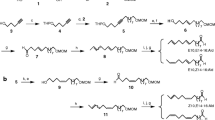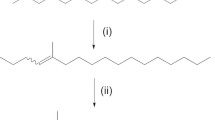Abstract
In 1996, the exotic white-spotted tussock moth (WSTM), Orgyia thyellina (Lepidoptera: Lymantriidae), was discovered in Auckland, New Zealand. Because establishment of WSTM would threaten New Zealand's orchard industry and international trade, eradication of WSTM with microbial insecticide was initiated. To monitor and complement eradication of WSTM by capture of male moths in pheromone-baited traps, pheromone components of female WSTM needed to be identified. Coupled gas chromatographic–electroantennographic detection analysis of pheromone gland extract revealed several compounds that elicited responses from male moth antennae. Mass spectra of the two most EAD-active compounds suggested, and comparative GC-MS of authentic standards confirmed, that they were (Z)-6-heneicosen-11-one (Z6–11-one) and (Z)-6-heneicosen-9-one, the latter termed here “thyellinone.” In field experiments in Japan, Z6–11-one plus thyellinone at a 100:5 ratio attracted WSTM males, whereas either ketone alone failed to attract a single male moth. Addition of further candidate pheromone components did not enhance attractiveness of the binary blend. Through the 1997–1998 summer, 45,000 commercial trap lures baited with 2000 μg of Z6–11-one and 100 μg of thyellinone were deployed in Auckland towards eradication of the residual WSTM population.
Similar content being viewed by others
REFERENCES
Arn, H., StÄdler, E., and Rauscher, S. 1975. The electroantennographic detector—a selective and sensitive tool in the gas chromatographic analysis of insect pheromones. Z. Naturforsch. 30c:722–725.
Arn, H., TÓth, M., and Priesner, E. 1992. List of Sex Pheromones of Lepidoptera and Related Attractants. 2nd ed. International Organization for Biological Control. Monfavet.
Grant, G. G., Frech, D., MacDonald, K. N., Slessor, K. N., and King, G. G. S. 1987. Copulation releaser pheromone in body scales of female whitemarked tussock moth, Orgyia leucostigma (Lepidoptera: Lymantriidae): Identification and behavioral role. J. Chem. Ecol. 13:345–356.
Gray, T. G., Slessor, K. N., Shepherd, R. F., Grant, G. G., and Manville, J. F. 1984. European pine shoot moth, Rhyacionia buoliana (Lepidoptera: Tortricidae): Identification of additional pheromone components resulting in an improved lure. Can. Entomol. 116:1525–1532.
Gries, G., Slessor, K. N., Gries, R., Khaskin, G., Wimalaratne, P. D. C., Gray, T. G., Grant, G. G., Tracey, A. S., and Hulme, M. 1997. (Z)-6,(E)-8-Heneicosadien-11-one: Synergistic sex pheromone component of Douglas-fir tussock moth, Orgyia pseudotsugata (McDunnough) (Lepidoptera: Lymantriidae). J. Chem. Ecol. 23:19–34.
Hosking, G. 1997. Public discussion paper: White-spotted tussock moth. Ministry of Forestry, PO Box 1610, Wellington, New Zealand.
Inoue, H. 1956. A revision of the Japanese Lymantriidae (I). Jap. J. Med. Sci. & Biol. 9:133–163.
Katritzky, A. R., Wu, H., and Xie, L. 1996. Benzotriazole-mediated [2,3]-Wittig rearrangement. General and Stereocontrolled syntheses of homoallyl alcohols and β,γ-unsaturated ketones. J. Org. Chem. 61:4035–4039.
Kim, C. H., Nam, S. H., and Llee, S.-M. 1982. Illustrated flora and fauna of Korea. Vol. 26. Insecta (VIII), Samwha Publ., Seoul. pp. 588–615.
Kimura, T., and Masaki, S. 1977. Brachypterism and seasonal adaptation in Orgyia thyellina Butler (Lepidoptera: Lymantriidae). Kontyu (Tokyo) 45(1):97–106.
Kishida, Y. 1992. 122. Lymantriidae, pp. 276, in Heppner, J.B. and H. Inoue. Lepidoptera in Taiwan. Vol. 1, part 2. Checklist Scientific Publ., Gainsville, Florida.
Kozhanchikov, I. V. 1950. Family Orgyidae, pp. 581, in Fauna USSR, Part 12. Moskva: Zool. Institute, Acad. Sci. USSR.
Miller, J. R., and Roelofs, W. L. 1978. Sustained-flight tunnel for measuring insect responses to wind-borne sex pheromones. J. Chem. Ecol. 4:187–198.
Sas/Stat. 1988. User's Guide, release 6.03 edition. SAS Institute Inc., Cary, North Carolina 27513.
Smith, R. G., Daterman, G. E., and Daves, G. D., Jr. 1975. Douglas-fir tussock moth: Sex pheromone identification and synthesis. Science 188:63–64.
Still, W. C., Kahn, M., and Mittra, A. 1978. Rapid chromatographic technique for preparative separation with moderate resolution. J. Org. Chem. 43:2923–2925.
Zhao, Z.-L. 1982. Lymantriidae. pp. 163–190, in Wang, P.-Y. et al. (eds.) Iconographia Heterocerorum Sinicorum. II Notodontidae, Lymantriidae, Arctiidae, Hypsidae, Amatidae. Science Press, Beijing pp. 135–235.
Author information
Authors and Affiliations
Additional information
Dedicated to my dear mother in honor of her 75th birthday
Rights and permissions
About this article
Cite this article
Gries, G., Clearwater, J., Gries, R. et al. Synergistic Sex Pheromone Components of White-Spotted Tussock Moth, Orgyia thyellina . J Chem Ecol 25, 1091–1104 (1999). https://doi.org/10.1023/A:1020833909739
Issue Date:
DOI: https://doi.org/10.1023/A:1020833909739




